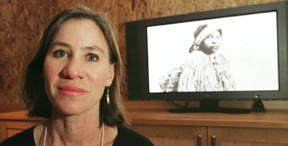The contemporary photograph shows a modest and rather unprepossessing building, the powerplant that is the only edifice left of the Port Blakely lumber mill.
Then the photograph dissolves into the sepia-tones of the 19th century, and the building is surrounded by the multitude of imposing structures that once formed the world’s biggest lumber mill, built in 1888, after the first mill burned.
The mill is the subject of the “Port Blakely: Memories of a Mill Town” by award-winning documentary film maker Lucy Ostrander and her husband Don Sellers, a former PBS “Frontline” cinematographer and editor.
The production is being aired on Bainbridge Island Broadcasting’s cable TV channel 6 throughout October.
The scale of the mill, the second built on the island and popularly called “The Great Mill,” is awesome and supports lines spoken by the film’s narrator, Bainbridge historian Jerry Elfendahl:
“There was something really incredible that happened here.”
But as the 12-minute film unfolds, one learns that the mix of cultures and ethnicities the mill attracted to Bainbridge was as remarkable as the technology.
The film alludes to the Italian, Filipino, Spanish and Chinese mill workers; a Hawaiian village on Toe Jam Hill, and the Japan Town on the hill above Port Blakely; the Suquamish Native Americans, who still maintained a seasonal village at Rockaway Beach; and the community of Scandinavian carpenters and ship-builders, several of whom, in one photo, stand dwarfed by the wooden ribs of a ship they are building.
Earl Hanson, who grew up in Eagledale, said. “Port Blakely was better known there (Norway) than Seattle.”
Another group who came to the island were sailors, who liked Bainbridge so well they jumped ship and hid out in the woods.
The process by which the big logs – mostly from southwest Washington – were floated into the harbor and up the sluiceway to the mill, is described.
There are poignant photographs of 20 loggers holding hands around a giant stump and 22 people and a horse and rider atop another.
But the focus of the film remains first-hand account and family lore.
Sam Nakao, born on the island in 1919, recalls the Takayoshi family’s making ice cream.
Suquamish Tribal member Charlie Sigo recounts how a mill supervisor renamed Sigo’s great-uncles Louis Napoleon and Sam Snyder.
“He had trouble pronouncing their names,” Sigo said. “That’s how they got two different last names. Both brothers – but two different names.”
And Elfendahl, who narrates the film in his own words, makes the past tangible:
“If you got off the steamboat at Port Blakely, you would hear the languages of people from all over the world spoken. You would hear the roar of the mill, smell the sweet smell of the fir sawdust, and breathe the smoke of the sawdust burner.”
Commissioned by IslandWood, formerly the Puget Sound Environmental Learning Center, the film was planned last June and finished by September, shot in just four days.
It packs a remarkable amount of historical detail into 12 minutes; concise editing makes the film feel spacious.
Ostrander, a 1982 Stanford graduate whose student film won a national PBS Academy Award, and who has since won four local Emmys, says the production has been a good way to re-enter film-making after a hiatus.
“The mandate was to make a film about islanders who came because of the mill,” she said.
“But what IslandWood had us make is actually a tremendous gift to the people who live here today.”


